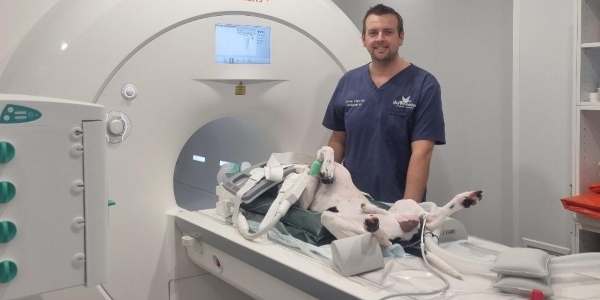
This is a preview of a full feature that appeared in theNovember edition of Synergy
Can you give us a little background on your experience?
It was a huge change going from a busy NHS hospital, imaging the general public, to imaging animals at a specialist referral veterinary hospital. I thought I’d be bitten far more working with animals than people, how wrong I was.
I have been qualified since 2008 and commenced my career working at New Cross Hospital in Wolverhampton. I started in X-ray and loved the experience. I threw myself into trauma as much as possible, enjoying adaptive techniques and found A&E work suited me. After 18 months I got a post in the cath labs where I stayed for another four years. I left in 2013 to learn MRI with Alliance Medical.
Mobile life presented a lot of different pressures, which I enjoyed. I learnt the basics, but wanted more complex scanning, so headed back to New Cross Hospital. I started in MRI and quickly learnt cardiac MRI, which was my favourite aspect of the job. I really enjoyed the different challenges it presented. The cardiologists I worked with always talked through the pathology and I find that makes scanning easier and more interesting. I then took an advanced practice role, which I did for a number of years until I found a post working with animals at the Dovecote Veterinary Hospital in Castle Donington, Leicestershire.
What made you want to become a veterinary radiographer?
I wasn’t aware of specialist veterinary hospitals and happened to come across a job advert for this post online by chance. It was daunting to go from an advanced practitioner in MRI, scanning people, a job I knew inside out, to working in a field where very few radiographers have the chance to encounter. There are plenty of challenges, but the rewards are fantastic. Who wouldn’t want to be playing with puppies at 9am on a Monday morning?
It isn’t all fun and games though. It is very demanding, as I normally see the complex cases that cannot be seen by a local vet. I mainly image neurology cases. For example, if a dog has a disc extrusion, brachial plexus tumours or a brain tumour, I perform a range of sequences including specialist scans like spectroscopy or diffusion tensor imaging.
Continue reading in the November edition of Synergy.
About Synergy
Synergy is the Society of Radiographer's essential publication featuring professional interviews, the latest advice for radiographers, and keeps you up to date on the latest news in the field.
Now published exclusively as an online magazine format, is available to all members of SoR and features the professional lives of radiographers from across the UK.
This month, we profile Professor Ruth Strudwick, educator and editor of Imaging and Oncology, to find out about her mission for patient-focused care. We also speak to a veterinary radiographer, hear a CoRIPS success story, and learn about an international outreach programme supported by SoR.
